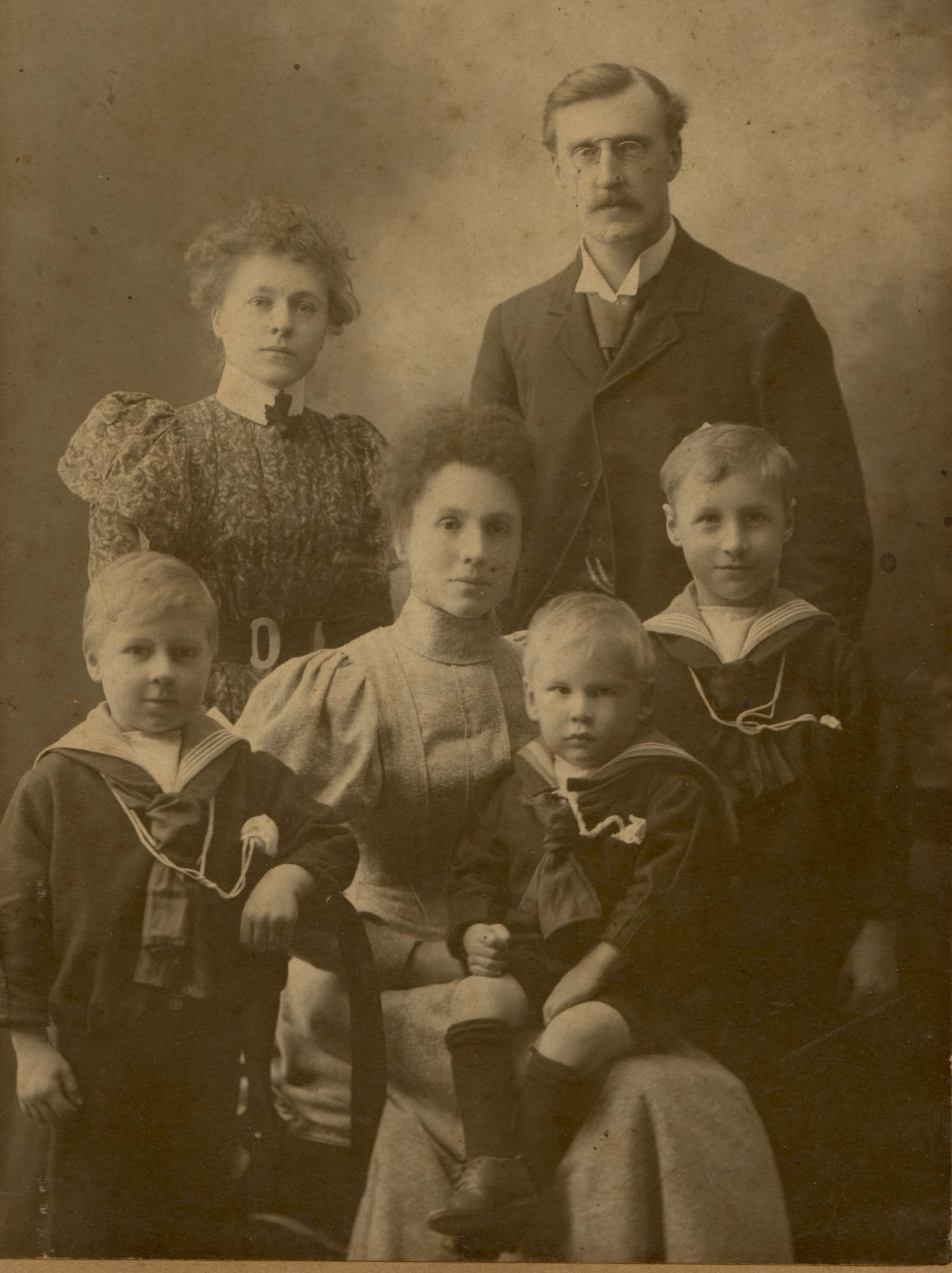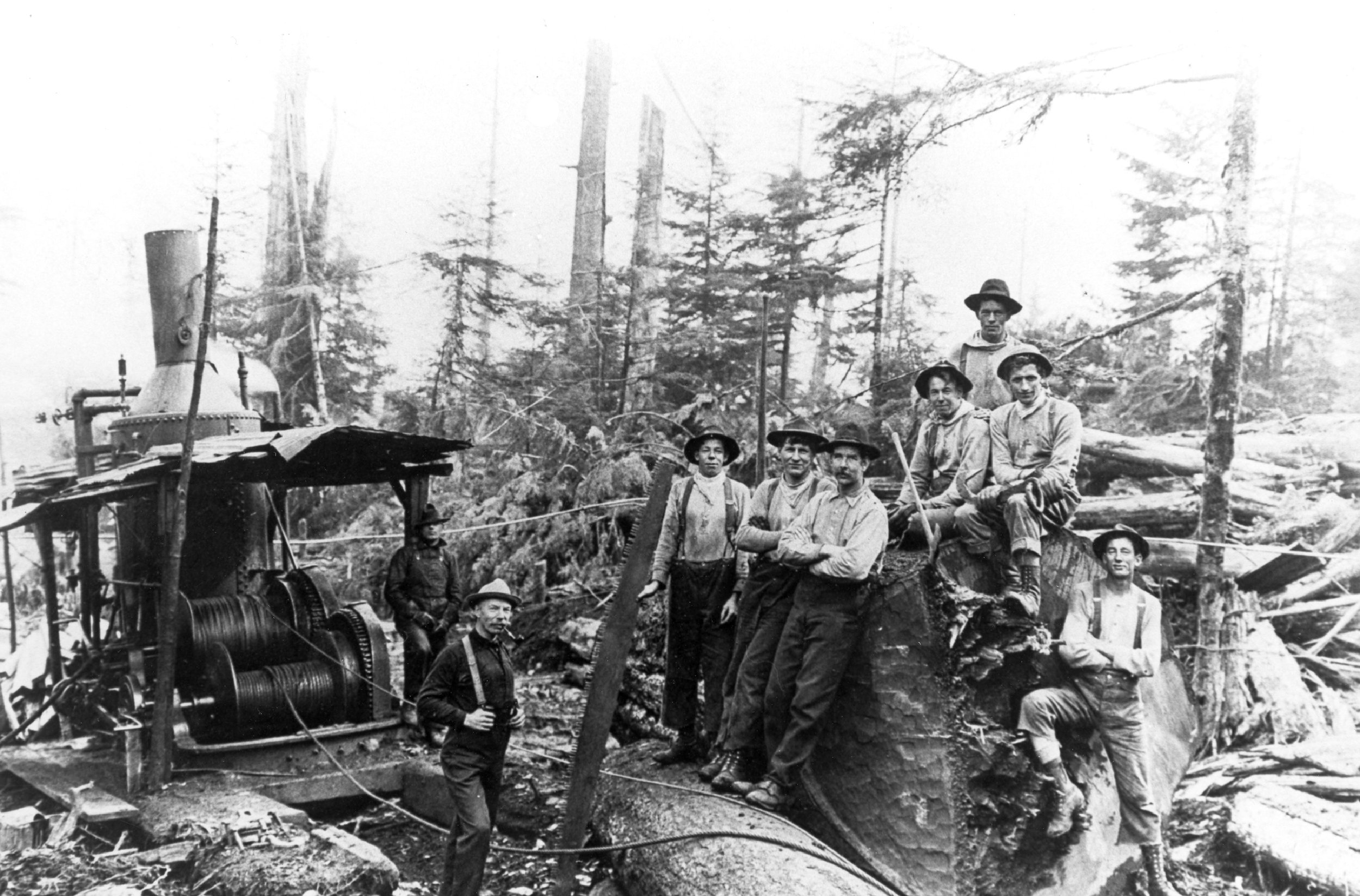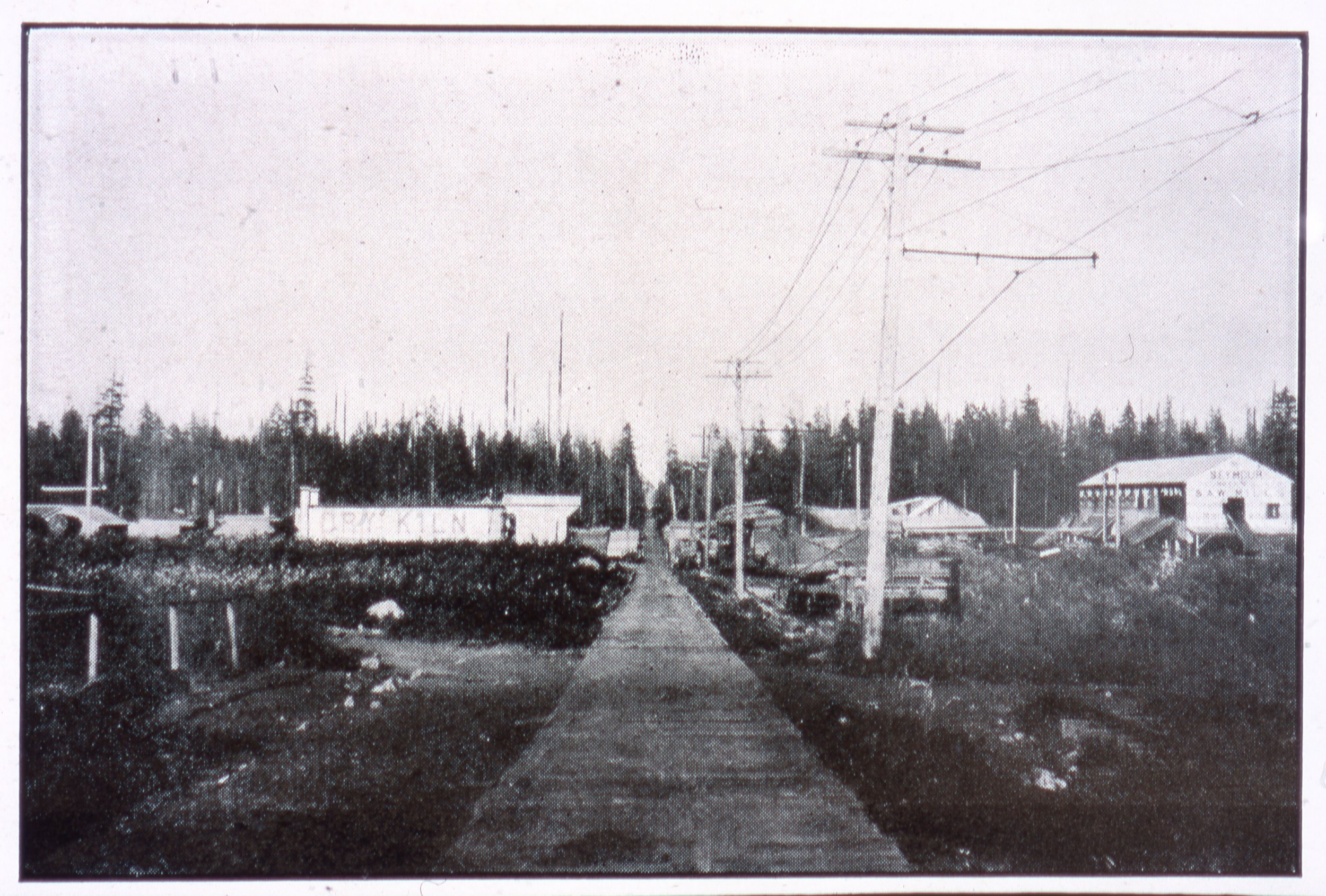One of the early pioneers on the Burrard Inlet’s North Shore, Arthur Diplock, is known for establishing in 1902 the Western Corporation, a multifaceted conglomerate involved in real estate, house building, road works and sales of coal and lumber. His legacy should be equally remembered for the construction in 1906 of what was arguably the first electric sawmill in the Pacific northwest. Glory times followed, but the Diplock story is not without its tragedy, as we will discover.
Arthur Diplock with his wife, Theresa (seated) and three elder sons (from left to right) Thomas, Cyril, and Fred, 1898. Also in the picture is Daisy Rischmann, Theresa’s younger sister. Courtesy, Sharon Gerbasi.
But first, a recap.
As you may be aware, it was Western Red Cedar that drew the early settlers to our shores. Like bees to a honey pot, lumbermen flocked to reap the rewards of the untouched timber. It was a mecca not without its challenges, however. Steep upper slopes and giant-sized trees required specialist lumbering. These were the days before mechanisation. Trees were felled by hand. A double bitted, narrow bladed, West Coast falling axe was used to get at the undercuts. The crosscut saw was widely used, with a springboard to avoid the thick tree butts, which the sawmills could not handle.
Traversing the dense forest was difficult. Initially, logs were towed along greased skid roads by teams of oxen. By the 1890s, however, horses had replaced oxen. The invention of the steam donkey enhanced the process. As the last century turned, yarding with donkey engines had become commonplace, with only a few operators continuing to use horses until the 1920s. And of course, the invention of the flume - a wooden water channel often raised on stilts - considerably eased the process.
It was the sawmill, however, that was the heart of the business. The first mill on the North Shore was established in 1863 by TW Graham Company, which had acquired 480 acres of timber located between present day Lonsdale Avenue and the mouth of Lynn Creek. Driven by a water wheel on a flume from the creek, the mill had a capacity of 40,000 feet of lumber per day.
SP Moody, an American from Maine, bought the mill in 1865 and in 1868 constructed a steam powered mill close to the original. By 1891, the mill, powered by 12 boilers, had become one of the most modern operations in the Pacific Northwest.
It was the introduction of electricity that enabled a quantum leap in sawmill efficiency. Arthur Diplock, founder, and president of the Western Corporation determined, in 1906, that his new saw mill, located at 17th street, two blocks in from Grand Boulevard, would be electric powered. Horses and steam donkeys were used to haul in the logs felled in the company’s sizeable timber reserves, but the twin, 56-inch saws and most of its other machinery were powered by two Canadian General Electric Company motors, one of 175 HP and one of 85 HP, and a Westinghouse motor of 50 HP.
Diplock sawmill at 17th Street, North Vancouver ca 1906, with Sikh, Chinese and Caucasian workers. Courtesy, MONOVA archives. Inventory number 257.
Diplock’s lumberjack crew and donkey engine between East 19th St and Mountain Highway. Courtesy, MONOVA archives. Inventory number 5006.
We are fortunate to have the memoir of Arthur Diplock’s second son, Thomas, who took an interest in the mill whilst at school on the North Shore and worked there for a time after finishing high school.
Thomas Diplock, as a young man. Courtesy, Sharon Gerbasi.
As recounted to me by Thomas’s granddaughter, Sharon Gerbasi, Thomas was in his eighties when he penned his memoir “Some Recollections of Early Life in the Sawmill Business on the North Shore,” although it is clear his memory had not faded:
“I was somewhat disillusioned on my first day of employment at the mill as I found that my duties consisted of painting the dimensions, lengths etc at the bottom of each lumber pile…From this I graduated to “yardman” pushing the carts loaded with lumber and assisting in piling lumber as it came from the mill.”
It was a formidable operation. Eighty men worked at the site which comprised - in addition to the sawmill and kiln buildings - bunk houses, offices, cook house and stables for the teams of horses.
Diplock sawmill with dry kiln and motor room re application of electrical power. Courtesy, MONOVA archives. Inventory number 12201.
As Thomas describes in his memoir:
“The employees came from many parts of Europe and Asia and, with Americans and Canadians, could almost have been representative of a minor United Nations. There were loggers and donkeymen, the millhands employed in the operation of the machinery, the teamsters with over a dozen teams of horses used for the log hauling and delivery of finished lumber, the Sikhs who composed most of the crew for the lumber yards, and in addition the sawyer who controlled the two main saws, the planer man, saw sharpeners, engineers.”
Diplock sawmill log pond and workmen’s housing ca 1906. Courtesy, MONOVA archives. Inventory number 401.
“On the eastern side of the mill was the sorting out pond where logs were dumped when brought in by a donkey engine with a cable about a mile in length.”
Four horses pulling a log wagon on East 19th St. Diplock and Wright. Seymour Lumber Company. Courtesy, MONOVA archives. Inventory Number 85.
“Other logs from more distant areas came in on heavy trucks hauled by six horse teams. In some cases, the logs were too large in diameter for the twin saws and had to be split in half by inserting blasting powder into holes bored in the logs. It took expert knowledge to split the log evenly as too heavy a charge of powder could cause considerable damage to the log.”
The fortunes of Arthur Diplock were not all rosy. Despite its prominent position in the business community, over-extension and a downturn in the real estate market caused the Western Corporation to collapse. The company went into receivership in October 1909, with its timber operation at 17th Street renewed as the Seymour Lumber Company. By 1911, with its nearby timber resources exhausted, the company acquired timber rights on Timber Mountain, (now known as Mount Fromme) east of Grouse Mountain. A plank road was constructed up St. Georges Avenue to the timber line. However, the cost involved in the trek down to 17th Street prompted a decision, shortly after, to move the mill further up the mountain. It was to be a fateful decision. In May 1912, a bush fire in Lynn Valley got out of control. With strong winds from the east, the fire swept across the mountain burning out the re-sited mill buildings and large quantities of cut logs awaiting transportation. As described in The Express newspaper at the time, without insurance, it was a catastrophe that the business could not survive.
Express Newspaper article dated 15th May 1912. Courtesy, newspapers.com.
In failing health, Arthur Diplock was to pass in May 1915 at the age of 52. By this time, Thomas, his son, had been captured whilst serving with the 7th (1st British Columbia) battalion at the Second Battle of Ypres during the first world war. Incarcerated in a German prison of war camp for three years, we can be thankful that he survived the war and was able, much later, to recount his early reminiscences.
History is often fickle in its recognition and much of the Diplock story may have been lost but for the foresight of Thomas’s granddaughter, Sharon Gerbasi in passing this information to the North Vancouver archives.
The Diplock sawmill will be remembered as being ahead of its time. Its use of electric power paved the way for the modern plants of today and, for this, Arthur Diplock and his band of multi-national workers must be congratulated.
Diplock sawmill workers ca 1906. Courtesy, MONOVA archives. Inventory number 263.
Except where indicated, text and images Copyright @ North Shore Heritage and Paul Haston. All rights reserved. Republication in whole or in part is prohibited without the written consent of the copyright holder. This includes, particularly, all images reproduced here courtesy of the extended Diplock family.
References:
MONOVA, North Vancouver Museum and Archives. https://monova.ca/archives/
Thomas Diplock, “Some reminiscences of early life in the sawmill business on the North Shore.”
“The Ambitious City,” Warren Sommer, Harbour Publishing, 1907
British Columbia City Directories 1860-1955, https://bccd.vpl.ca/









